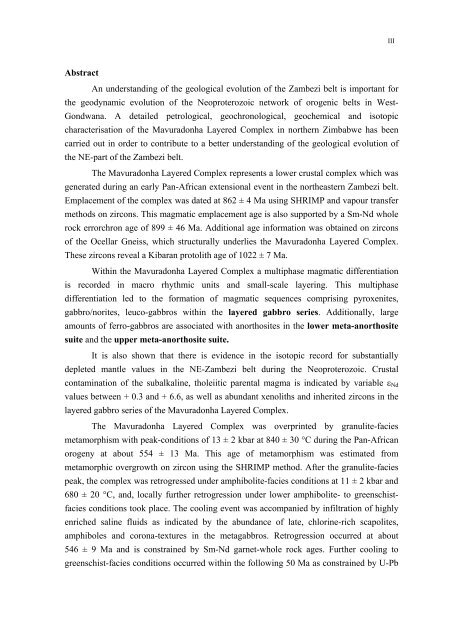The Mavuradonha Layered Complex: Neoproterozoic ... - ArchiMeD
The Mavuradonha Layered Complex: Neoproterozoic ... - ArchiMeD
The Mavuradonha Layered Complex: Neoproterozoic ... - ArchiMeD
You also want an ePaper? Increase the reach of your titles
YUMPU automatically turns print PDFs into web optimized ePapers that Google loves.
Abstract<br />
An understanding of the geological evolution of the Zambezi belt is important for<br />
the geodynamic evolution of the <strong>Neoproterozoic</strong> network of orogenic belts in West-<br />
Gondwana. A detailed petrological, geochronological, geochemical and isotopic<br />
characterisation of the <strong>Mavuradonha</strong> <strong>Layered</strong> <strong>Complex</strong> in northern Zimbabwe has been<br />
carried out in order to contribute to a better understanding of the geological evolution of<br />
the NE-part of the Zambezi belt.<br />
<strong>The</strong> <strong>Mavuradonha</strong> <strong>Layered</strong> <strong>Complex</strong> represents a lower crustal complex which was<br />
generated during an early Pan-African extensional event in the northeastern Zambezi belt.<br />
Emplacement of the complex was dated at 862 ± 4 Ma using SHRIMP and vapour transfer<br />
methods on zircons. This magmatic emplacement age is also supported by a Sm-Nd whole<br />
rock errorchron age of 899 ± 46 Ma. Additional age information was obtained on zircons<br />
of the Ocellar Gneiss, which structurally underlies the <strong>Mavuradonha</strong> <strong>Layered</strong> <strong>Complex</strong>.<br />
<strong>The</strong>se zircons reveal a Kibaran protolith age of 1022 ± 7 Ma.<br />
Within the <strong>Mavuradonha</strong> <strong>Layered</strong> <strong>Complex</strong> a multiphase magmatic differentiation<br />
is recorded in macro rhythmic units and small-scale layering. This multiphase<br />
differentiation led to the formation of magmatic sequences comprising pyroxenites,<br />
gabbro/norites, leuco-gabbros within the layered gabbro series. Additionally, large<br />
amounts of ferro-gabbros are associated with anorthosites in the lower meta-anorthosite<br />
suite and the upper meta-anorthosite suite.<br />
It is also shown that there is evidence in the isotopic record for substantially<br />
depleted mantle values in the NE-Zambezi belt during the <strong>Neoproterozoic</strong>. Crustal<br />
contamination of the subalkaline, tholeiitic parental magma is indicated by variable εNd<br />
values between + 0.3 and + 6.6, as well as abundant xenoliths and inherited zircons in the<br />
layered gabbro series of the <strong>Mavuradonha</strong> <strong>Layered</strong> <strong>Complex</strong>.<br />
<strong>The</strong> <strong>Mavuradonha</strong> <strong>Layered</strong> <strong>Complex</strong> was overprinted by granulite-facies<br />
metamorphism with peak-conditions of 13 ± 2 kbar at 840 ± 30 °C during the Pan-African<br />
orogeny at about 554 ± 13 Ma. This age of metamorphism was estimated from<br />
metamorphic overgrowth on zircon using the SHRIMP method. After the granulite-facies<br />
peak, the complex was retrogressed under amphibolite-facies conditions at 11 ± 2 kbar and<br />
680 ± 20 °C, and, locally further retrogression under lower amphibolite- to greenschistfacies<br />
conditions took place. <strong>The</strong> cooling event was accompanied by infiltration of highly<br />
enriched saline fluids as indicated by the abundance of late, chlorine-rich scapolites,<br />
amphiboles and corona-textures in the metagabbros. Retrogression occurred at about<br />
546 ± 9 Ma and is constrained by Sm-Nd garnet-whole rock ages. Further cooling to<br />
greenschist-facies conditions occurred within the following 50 Ma as constrained by U-Pb<br />
III

















